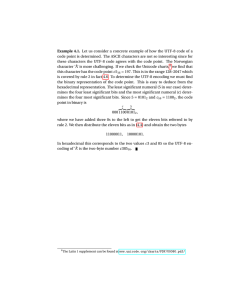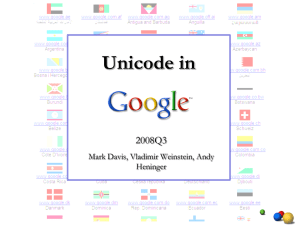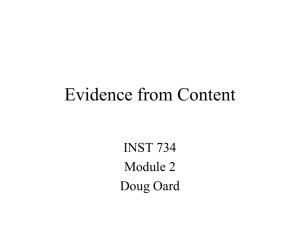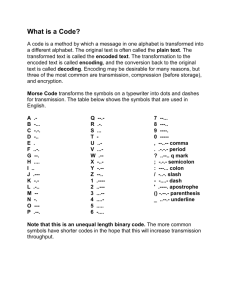Java Web App Unicode Enabement
advertisement
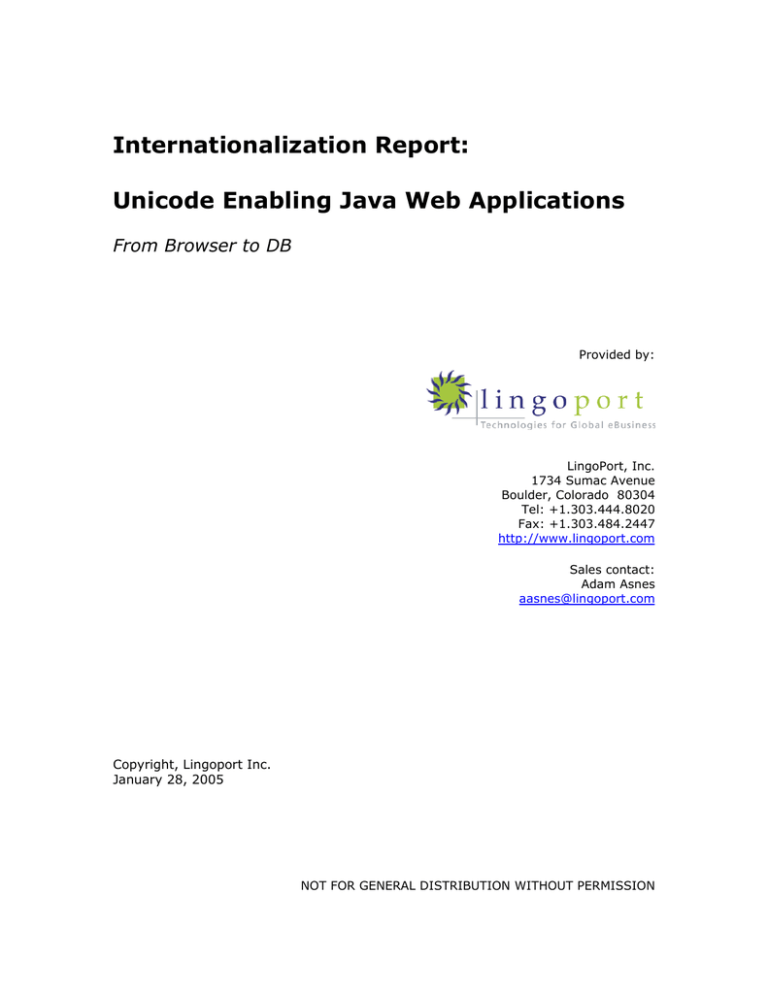
Internationalization Report:
Unicode Enabling Java Web Applications
From Browser to DB
Provided by:
LingoPort, Inc.
1734 Sumac Avenue
Boulder, Colorado 80304
Tel: +1.303.444.8020
Fax: +1.303.484.2447
http://www.lingoport.com
Sales contact:
Adam Asnes
aasnes@lingoport.com
Copyright, Lingoport Inc.
January 28, 2005
NOT FOR GENERAL DISTRIBUTION WITHOUT PERMISSION
Confidential and Proprietary to Lingoport
Table of Contents
Java Web Applications and Unicode ................................................................... 3
UTF-8 Enabling .................................................................................................. 3
Application Server UTF-8 Enabling...................................................................... 3
JSP File UTF-8 Enabling..................................................................................... 3
HTML File UTF-8 Enabling.................................................................................. 4
JavaScript UTF-8 Enabling................................................................................. 4
Database Unicode Enabling ............................................................................... 4
Oracle Data Types............................................................................................ 5
Other Encoding Tasks .......................................................................................... 6
Convert Properties Files to Unicode Escapes ........................................................ 6
About Lingoport ............................................................................................... 8
Unicode Enabling Java Web Apps
Lingoport, Inc.
Page 2
+1.303.444.8020
January 28, 2005
info@lingoport.com
Confidential and Proprietary to Lingoport
Java Web Applications and Unicode
Java is a language well suited to internationalization because of its native Unicode
character support and robust locale-specific functionality. There are some steps that need
to be taken, however, to enable Unicode support in a Java web application, and these
steps are dependent on the components being used (database, application server, etc.).
This document describes the steps to be taken to set up a Java web application to use
Unicode.
UTF-8 Enabling
UTF-8 is the preferred encoding form of Unicode to use with HTML, and by extension JSP,
Servlets, etc. because ASCII markup remains in ASCII, which means smaller file sizes
being transferred over the Internet (assuming the files are more markup than content in
the case of Asian languages).
To enable a Java web application to use UTF-8, it is necessary to include this information
in certain key places so that the application knows what encoding to use when delivering
output or receiving input. There are five possible areas for this to be defined:
1.
2.
3.
4.
5.
The
The
The
The
The
application server (startup script/app config)
JSP files (page directive)
HTML files (content-type meta tag)
JavaScript files/code blocks (charset attribute)
database (client and server)
Application Server UTF-8 Enabling
By default, an application server uses the encoding of the system on which it is running,
defined in the system property file.encoding. On English systems this property will
likely be defined as either ISO-8859-1 (Latin-1, Unix-based systems) or Cp1252
(Windows Latin-1 charset).
In the event this value is not correct for the application (as is the case for our purposes),
some application server solutions recommend redefining the file.encoding property
during system startup. For example, the Apache group recommends changing the Tomcat
startup script (catalina.bat or catalina.sh) to add the switch –Dfile.encoding=UTF-8 to
the startup call to the Java executable. This ensures that the http response encoding will
default to UTF-8, though this can be overridden within the java Servlet code as needed.
The Orion Application Server, to provide another example, uses a different approach.
Under Orion, each web application has an Orion-specific configuration file called orionweb.xml. This file can be found under the application deployment location
(ORION_HOME/application-deployments/<deploymentName>/<warname(.war)>/orionweb.xml), or in the application's WEB-INF directory if not deployment-directory is
specified in server.xml. This file contains a default-charset value (set to ISO-8859-1 by
default) that should be changed to UTF-8.
JSP File UTF-8 Enabling
The encoding of a JSP file is defined by placing a page directive at the top of the file and
including pageEncoding and/or contentType attributes. In its most verbose form, here is
a page directive that defines UTF-8 as the encoding/charset:
Unicode Enabling Java Web Apps
Lingoport, Inc.
Page 3
+1.303.444.8020
January 28, 2005
info@lingoport.com
Confidential and Proprietary to Lingoport
<%@ page pageEncoding="UTF-8" contentType="text/html; charset=UTF-8" %>
It might seem redundant to have both the pageEncoding and contentType definitions
contain UTF-8, but they are used for different purposes. The first, pageEncoding, is an
indication to the web container of the file's encoding so that it is compiled using that
encoding. The contentType attribute, on the other hand, becomes the Content-Type
header sent in the response to the client's request.
Ideally, setting the default character set of the application/application server to UTF-8
would be enough to ensure that the application uses UTF-8 as its encoding throughout. In
practice, however, it is a good idea to be as explicit as possible to help ensure that any
issues arise aren't related to encoding. This means including this page directive in every
JSP file.
HTML File UTF-8 Enabling
An HTML file defines its encoding similarly to JSP, but defining its content-type. In HTML
this is done using a meta tag:
<meta http-equiv="Content-Type" content="text/html;charset=utf-8">
The meta tag should be defined before the title element in the head of the document.
(Note that case is not important; both "utf-8" and "UTF-8" will work.)
It could be argued that this is not strictly necessary, since the server's response already
contains a Content-Type header with charset. While this is true, the same logic to justify
the JSP page directive can be used here, which is that the more explicit you are in
defining the encoding, the less likely that issues will arise related to encoding.
JavaScript UTF-8 Enabling
It is possible to indicate the encoding of a JavaScript block or file by including the charset
attribute in the script start tag, for example:
<script src="functions.js" type="text/javascript" charset="UTF-8"></script>
In practice this in probably unnecessary provided that JavaScript has been properly
internationalized (strings externalized, etc.). However, if a JavaScript code block or file
happens to contain an extended character, including this attribute isn't a bad idea. Of
course, it will be necessary to verify that code or file is actually encoded as UTF-8,
otherwise the extended characters will not display correctly.
Database Unicode Enabling
This section will discuss Unicode enablement of Oracle and SQL Server db platforms.
Other platforms have different Unicode configurations Steps.
Oracle
When Oracle is the db platform, the decision must be made whether the db should store
character data in the UTF-8 (multibyte) Unicode encoding or in the UTF-16 (double-byte)
Unicode encoding, as Oracle supports both. When the db is likely to contain mostly ASCII
Unicode Enabling Java Web Apps
Lingoport, Inc.
Page 4
+1.303.444.8020
January 28, 2005
info@lingoport.com
Confidential and Proprietary to Lingoport
character data, UTF-8 is generally the best solution. Within UTF-8, ASCII data is encoded
with its original, single-byte ASCII code point, meaning no extra space is required for the
storage of UTF-8 data that falls within the ASCII range. Character data beyond the ASCII
range is encoded with either two or three bytes.
When the majority of character data in the db is non-ASCII data (such as Japanese, etc.)
it is a wiser decision to use the UTF-16 encoding, which encodes each character with two
bytes with the exception of surrogate pairs. This proves a space saver when lots of Asian
characters are stored, as UTF-8 encodes each Asian character with three bytes.
Oracle UTF-8
The steps, if any, to communicate with a UTF-8 encoded Oracle database depend on how
it is being accessed.
If the database is being accessed through such utilities as SQLPLUS, it is necessary to
define an environmental variable on the client that indicates the encoding of the database
you are connecting to. The following command sets the NLS_LANG environmental
variable to UTF-8 for US on a Unix machine in the bash shell:
$ export NLS_LANG=American_America.AL32UTF8
If a client is accessing the database via Java using either the JDBC thin driver or the OCI
driver, it is not necessary to do anything additional on that client since both drivers will
determine database encoding and transparently perform any necessary conversions
(UTF-8 to UTF-16 in this case). This is true both for querying from and updating to the
database.
Oracle UTF-16
In order to store character data in the UTF-16 encoding, Oracle requires use of NCHAR,
And NVARCHAR2 data types. As mentioned previously in this document, Oracle refers to
this double-byte Unicode encoding as AL16UTF16.
Oracle Data Types
Within Oracle, the character encoding for a database is usually defined when the
database is created. With the exception of the UTF-16 encoding, the character encoding
is specified as the CHARACTER SET perameter inside the CREATE DATABASE statement.1 If
UTF-16_-_AL16UTF16 is the desired database encoding, the encoding is instead specified
as the NATIONAL CHARACTER SET parameter in the CREATE DATABASE statement:
CREATE DATABASE sample
CONTROLFILE REUSE
LOGFILE
GROUP 1 ('diskx:log1.log', 'disky:log1.log') SIZE 50K,
GROUP 2 ('diskx:log2.log', 'disky:log2.log') SIZE 50K
MAXLOGFILES 5
MAXLOGHISTORY 100
MAXDATAFILES 10
MAXINSTANCES 2
ARCHIVELOG
CHARACTER SET WE8ISO8859P1
1 Choosing
a Character Set.
http://www.cs.utah.edu/classes/cs5530/oracle/doc/B10501_01/server.920/a96529/ch2.htm#104327
Unicode Enabling Java Web Apps
Lingoport, Inc.
Page 5
+1.303.444.8020
January 28, 2005
info@lingoport.com
Confidential and Proprietary to Lingoport
NATIONAL CHARACTER SET AL16UTF16
DATAFILE
'disk1:df1.dbf' AUTOEXTEND ON,
'disk2:df2.dbf' AUTOEXTEND ON NEXT 10M MAXSIZE UNLIMITED
DEFAULT TEMPORARY TABLESPACE temp_ts
UNDO TABLESPACE undo_ts
SET TIME_ZONE = '+02:00';
Once AL16UTF16 UTF-16 has been passed in as the NATIONAL CHARACTER SET VALUE in
the Create Database statement, Oracle will automatically store all text defined as SQL
“N” data types (NCHAR, NVARCHAR2, NCLOB) in the UTF-16 encoding. Oracle will store
UTF-16 characters into columns of these data types regardless of the value passed into
the CHARACTER SET perameter. The CHARACTER SET encoding will continue to be used for
other character data defined as VARCHAR and CHAR types. The NCHAR data types have
been redefined in Oracle9i to be double-byte Unicode data types exclusively.2
SQL SERVER Data Types and Encoding
SQL Server 2000 employs only the UCS-2 Unicode encoding. Though UCS-2 is an earlier
version of Unicode, Microsoft’s implementation of UCS-2 in SQL Server is compatible with
UTF-16.
The difference between UCS-2 and UTF-16 is the support for surrogate code units, a
range of 16-bit code units reserved for use in UTF-16 to represent characters with
Unicode values in the range U+10000 – U+10FFFF.
The surrogate code units are always used in pairs, with one high (range D800 – DBFF)
and one low (range DC00 – DFF) surrogate code unit.
Although SQL Server is not aware of surrogates, SQL Server will not corrupt the data in a
database that contains them; it will treat the pair of surrogate code points as two
separate (undefined) characters.
On Windows, both UCS-2 and UTF-16 are stored in a Little Endian manner.
In SQL Server, all fields that will store UCS-2 data, must be defined as “N” data types.3
Other Encoding Tasks
There one remaining task related to encoding that must be performed to ensure proper
character handling by the Java web application: convert translated properties files to
Unicode escapes.
Convert Properties Files to Unicode Escapes
Properties files do not provide a mechanism for indicating the files' encoding, and so the
files must be encoded in a form that Java can interpret correctly as Unicode characters.
This form is known as Unicode escapes. A Unicode escape indicates a Unicode character
value and is interpreted by Java into that character. Some examples:
2
Supporting Multilingual Databases with Unicode.
http://www.cs.utah.edu/classes/cs5530/oracle/doc/B10501_01/server.920/a96529/ch5.htm#1017484
3
Kaplan, Michael. “International Features in Microsoft SQL Server 2000.” April, 2001.
http://msdn.microsoft.com/library/default.asp?url=/library/enus/
dnsql2k/html/intlfeaturesinsqlserver2000.asp
Unicode Enabling Java Web Apps
Lingoport, Inc.
Page 6
+1.303.444.8020
January 28, 2005
info@lingoport.com
Confidential and Proprietary to Lingoport
"\u0041" = 'A' (capital letter A)
"\u263A" = '☺' (smiley face)
"\u65E5" = '日' (Chinese/Japanese character for "sun")
Properties files containing extended characters should be processed so that those
characters are converted to Unicode escapes. This in accomplished on the command line
using the native2ascii command, which takes an -encoding switch to indicate the
encoding of the file, the name of the source file, and the name of the target file. For
example, assuming you have a set of properties files with the base name "Messages,"
here is the command to convert the Japanese file from UTF-8 to Unicode escapes:
$ native2ascii -encoding UTF-8 Messages_ja.properties Messages_ja.properties
This example uses the same file name for the source and the target. The process can also
be reversed, for example if you need to be able to edit the text in the properties files
(likely at some point), by including the -reverse switch.
$ native2ascii –reverse -encoding UTF-8 Messages_ja.properties \
> Messages_ja.properties
The -reverse switch changes the meaning of the -encoding switch from source
encoding to target encoding.
In actuality, there is one other possible encoding to use with properties files: the default
encoding of the system. So if the system uses a Latin-1 encoding such as ISO-8859-1 or
Cp1252, properties files for Western European languages could be encoding in either of
these without needed to convert to Unicode escapes. This not recommended in a
multilingual environment, however, since ideally all files should be encoded as UTF-8
during editing, and converted to Unicode escapes for deployment. The value of this
approach is that all files are uniform, so there is no need to keep track of different
encodings for different files.
Unicode Enabling Java Web Apps
Lingoport, Inc.
Page 7
+1.303.444.8020
January 28, 2005
info@lingoport.com
Confidential and Proprietary to Lingoport
About Lingoport
Lingoport provides internationalization services and its Globalyzer software, which
combine to help our clients to become nimble and effective in providing high quality
products for any worldwide locale. Services include internationalization architectural
planning, internationalization code development and testing as well as internationalization
training. Globalyzer helps teams of developers find and fix internationalization issues
buried within large volumes of source code. You can find out more about Lingoport at
http://www.lingoport.com.
Unicode Enabling Java Web Apps
Lingoport, Inc.
Page 8
+1.303.444.8020
January 28, 2005
info@lingoport.com
